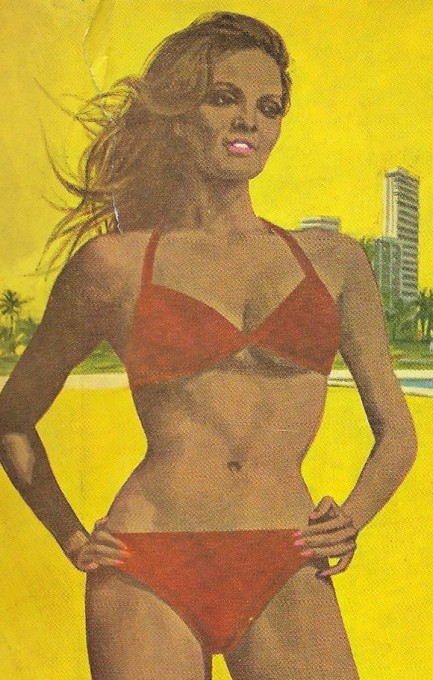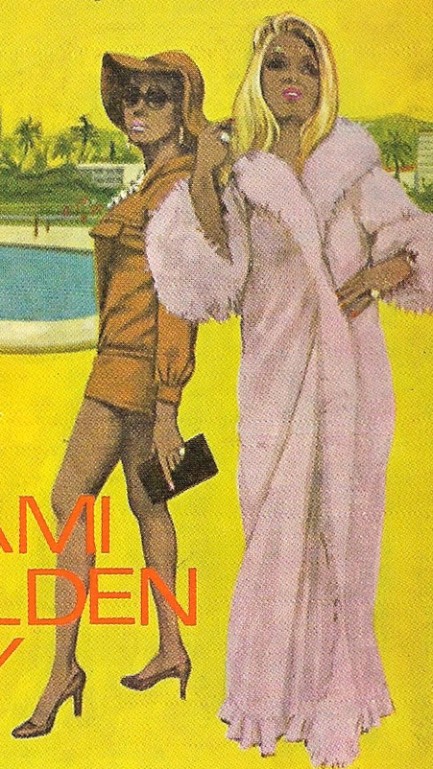 All you have to do is peel and enjoy. 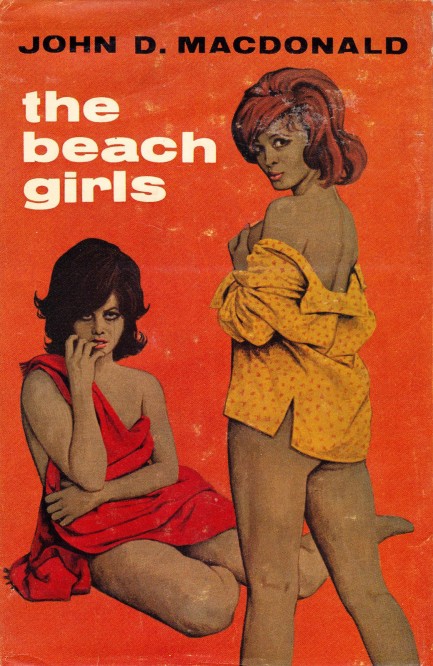
Above: another brilliant hardcover dust jacket from illustrator Barbara Walton, this time for John D. MacDonald's The Beach Girls, for British publisher Robert Hale, Ltd. The book was originally published in the U.S. in 1959, but the above edition came in 1968. To see more from Walton just click her keywords below, and to learn about the book click here.
 Thank you very much. Next I'd like to massacre a song by Joan Baez. 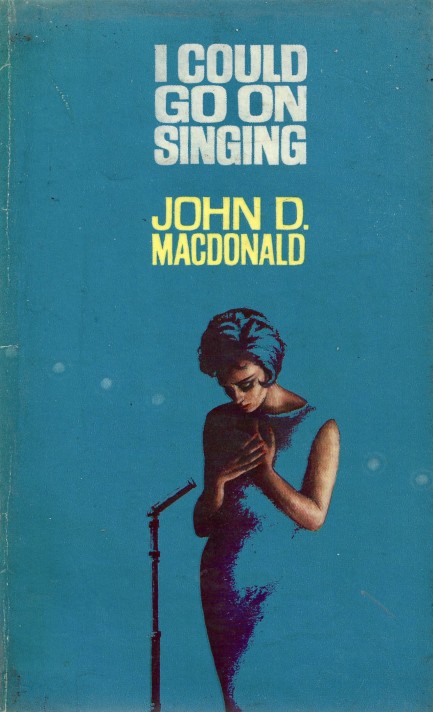
Since we took a look at Barbara Walton's cover work recently we thought we'd circle back to her with an effort for John D. MacDonald's I Could Go On Singing, originally published in 1963 with this Robert Hale Ltd. hardback coming in ’64. This is very different, very minimalist work from Walton compared to what we showed you last time, but it just demonstrates her broad range. It's different work for pop fiction icon MacDonald too, as it was a novelization for a 1963 movie of the same name. Hey, whatever pays the bills. We didn't read it, but we gather that he managed to put his unique stamp on it.
 British adventurers get high in South Asia. 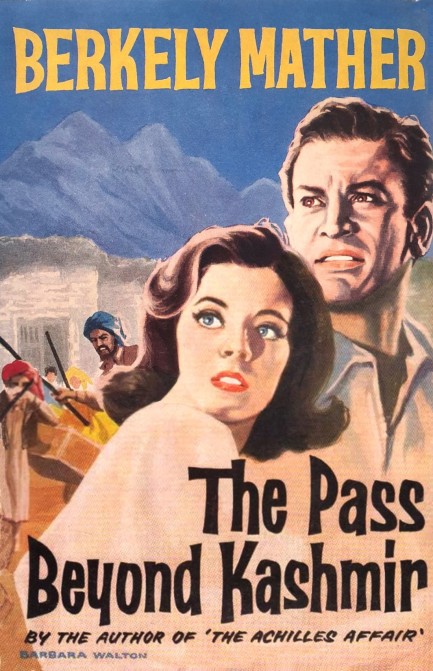
The cover you see above for Berkely Mather's, aka John Evan Weston-Davies', 1960 adventure The Pass Beyond Kashmir is one of the more pleasing we've come across. It's by Barbara Walton, a preeminent dust sleeve illustrator from the 1950s until around 2000. We've featured her a few times, such as here, here, and here, and this effort maintains her incredibly high standard. The scene depicted makes one think there's a major romantic subplot in the novel, but the love interest is in the book for maybe twenty pages. It isn't Walton's fault that the art gave us expectations that weren't met. It happens with covers sometimes. No romantic adventure here.
The story actually revolves around a sardonic and extremely determined ex-intelligence operative named Idwal Rees who gets caught up in a search for missing documents in the Himalayas that might reveal the location of an oil discovery. The action takes the form of a quest from Bombay-Mumbai into the high mountains, with new difficulties encountered in each stop by he and partner Smedley, servant Safaraz, and reluctant informer Poison. Each obstacle is followed by desperate problem solving, and hairsbreadth escapes. The aforementioned sort-of love interest, a nurse named Claire Culverton, is mainly a source of consternation for Rees and a focus for his chauvinism.
The set-up and framework are fine, but we felt that the book got bogged down with too much local color. Obviously, authors wish to impart that they've at a minimum done their homework, and at a maximum lived some version of what they're writing about, but there's also such a thing as narrative flow. We get it—Mather was really in India and Pakistan. He even served in the army there. But in our opinion he needed another pass from an editor to make for a better book. Still, as it resolved, it was decent, though anyone of Indian, Pakistani, or Chinese descent—or of good conscience—will bristle at the treatment meted out by Rees and other Brits. But you know that going in, right?
 Herbert Kastle writes South Beach as Sodom in his sprawling kidnap thriller. 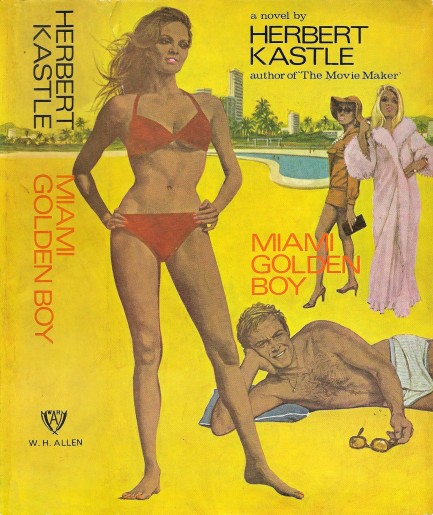
Miami Golden Boy is the wrong title for this book. It's too trite for the tale of a plot to kidnap the invalid former president of the U.S., which intersects a plot by Havana expats to return to Cuba and depose Fidel Castro. While the book gets its name from the ostensible central figure Bruce Golden, there's a vast assortment of characters, including a Kennedyesque political clan, that keeps him out of the narrative for entire chapters. These characters have deeply detailed personal lives that add dimension but strain credulity. One secretly has cancer, one is secretly gay, one is secretly sadistic, one is secretly a pedophile, one is being blackmailed, one is secretly a drug addict, one is secretly suicidal. It's a lot. But okay, the only question that matters is does it all work? Well, mostly. Kastle uses these secrets to weave a tale of decadent American decline, with South Beach as a backdrop. A choice example:
“The country is beginning to stink. Our stated goals and our actual goals are drawing farther and farther apart. And the divergence is tearing us apart. We've either got to bring the actual goals closer to the stated goals—reduce the materialism in our lives, the idiocy of our anti-communist crusades, the cruelty and blindness of our dealings with blacks—or admit that the stated goals are false.”
Kastle wrote that fifty-two years ago, and we know how things have gone since then. His abduction plot is a symptom of the greed, hypocrisy, and decline he details. The scheme involves several characters using several other characters as pawns. The lever in most cases is sex, and the book is pretty well packed with sexual content, occasionally explicit, and in one case violent. Then there's that pedo thing too. Kastle doesn't shy away from it, though you may wish he had. The tapestry of duplicity and manipulation, in terms of how it relates to the kidnap, needs to weave together in perfect synchronization, and of course doesn't. The scheme blows up spectacularly. If it didn't there'd be no book. Conversely, Kastle brings everyone's secret stories to miraculous conclusions within the space of the final thirty pages. That's the drawback of so many characters—a few story arcs don't end convincingly.
Even so, the one thing you cannot say is that Kastle doesn't know how to write. His skillful prose makes the slam bang climax almost believable. Bruce Golden, a bit of a shallow playboy, isn't a great guy but at least he isn't a killer, kidnapper, or political plotter, so he's the character you root for. His love interest Ellie De Wyant, on the other hand, is a crucial if unwitting cog in the kidnapping, which means if Golden is to have her he may have to do something he's never done in his entire life—show courage in the face of danger. Will he or won't he? We think Miami Golden Boy is worth a read to find the answer. And speaking of worth, books with Barbara Walton cover art aren't usually cheap, but this one from the publisher W.H. Allen was. We got lucky. Walton was one of the top illustrators of her era. See more from her here and here.
 Going under for the second time. 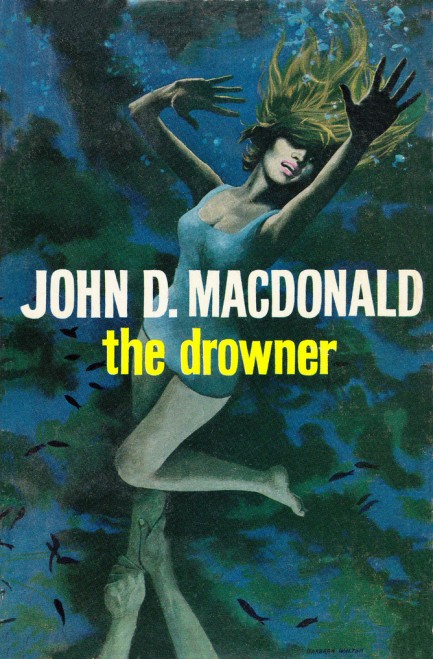
John D. MacDonald was a widely read author whose popularity endured, which means there are multiple editions of most of his books. We already showed you a cover for his 1963 thriller The Drowner. Here's a second version. This came from publisher Robert Hale Ltd. of England in 1964, and the art is by the incomparable Barbara Walton.
 Murder mystery explores the turbulent years of pre-Malaysia Singapore. 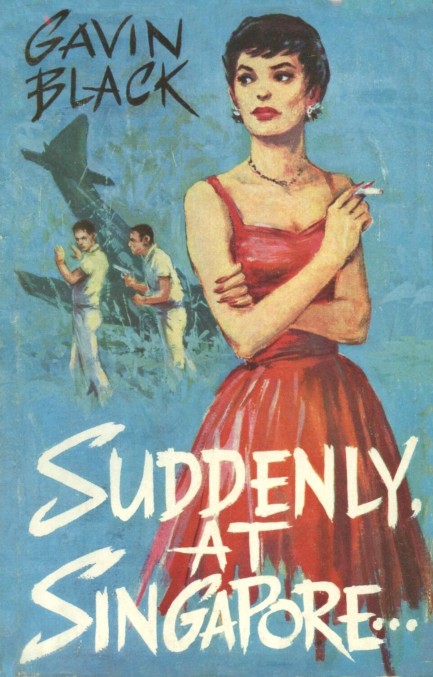
We grabbed this beautiful hardcover copy of Suddenly, at Singapore from Scottish publishers William Collins, Sons & Co. for two reasons. First, the cover art is by the legendary Barbara Walton, one of the great illustrators of the mid-century period, and the title promises exotic thrills. Though we're lucky enough to live in an exotic land ourselves, we never get tired of tales set in Asia, Africa, or the Mediterranean. And speaking of exotic, Gavin Black is a pseudonym far less exotic than the author's real name—Oswald Wynd. Why use a pen name when you're named Oswald Wynd? Beats us, though the fake name does sound more real.
Anyway, Suddenly, at Singapore involves the Harris Brothers, two adventurous anglos born and raised in Singapore who own a shipping company that, in addition to legit cargos, transports black market weapons around the Java Sea in a fleet of Chinese junks. The story opens with the older brother Jeff being murdered, and younger brother Paul vowing revenge—as soon as he figures out who ordered the killing. He's also involved in an as yet unconsummated martial affair, and is trying to send his wife back to the U.S. to get her out of his hair. The two plotlines eventually braid together, and pretty soon the hero and both his women are in all kinds of difficulties.
This was a quick read, decent not great, but with nice local color derived from Black's/Wynd's time spent in the region. The story takes place before Malaya, Singapore, North Borneo and Sarawak merged into Malaysia, and Black channels some of the political tension and economic lawlessness that prevailed during that time, but doesn't delve into it in a detailed way. He would do that later, though—we gather that this was the first of numerous Paul Harris thrillers. We also hear from those in the know that Suddenly, at Singapore is the worst of the lot, so we may try the second book Dead Man Calling when we get the hankering for South Seas craziness again.
 The pieces of treasure are worth a fortune. The nuggets of wisdom—not so much. 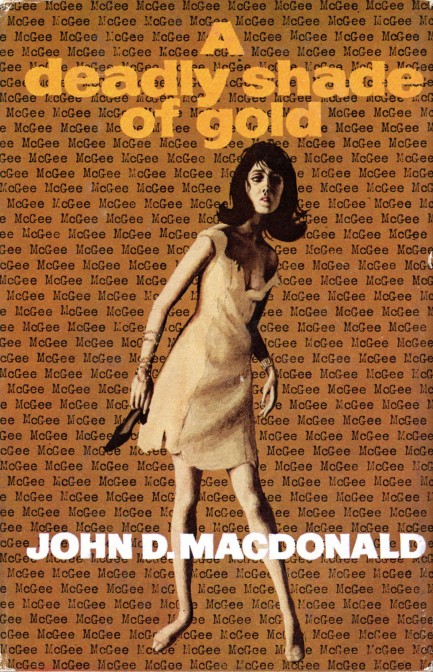
Barbara Walton art graces the dust sleeve of John D. MacDonald's A Deadly Shade of Gold. It was published in 1967 by Robert Hale, Ltd. two years after the book's U.S. debut. MacDonald's franchise character Travis McGee kicks ass and dispenses unsolicited wisdom, and while the action is fun, the philosophizing is less so. The latter is sometimes insightful when directed at civilization, but is often sweeping and incorrect when directed at civilians. Vacationers are this way. College boys are that way. Lesbians are this way. We've had plenty of experiences with all the categories of humans McGee thinks of as tedious and banal, and we found them to be as varied and interesting as any other group.
The book, though, is engrossing, built around our favorite film noir and crime fiction device—a trip to Mexico, with the action set in the fictional coastal town of Puerto Altamura. There McGee seeks to uncover the killers of a close friend and determine the whereabouts of a set of golden pre-Colombian statuettes. Five entries into the series and MacDonald seems to have hit his stride. We liked this caper, though McGee is obviously going to keep making dubious pronouncements (we sent a supposed-to-be racially insightful passage from the seventh entry Darker than Amber to a friend who'd be qualified to judge, and he said: “What idiot wrote that?”). If you're curious about the character or author you can learn more at thetrapofsolidgold.blogspot.com, pretty much the last word on all things Travis McGee and John D. 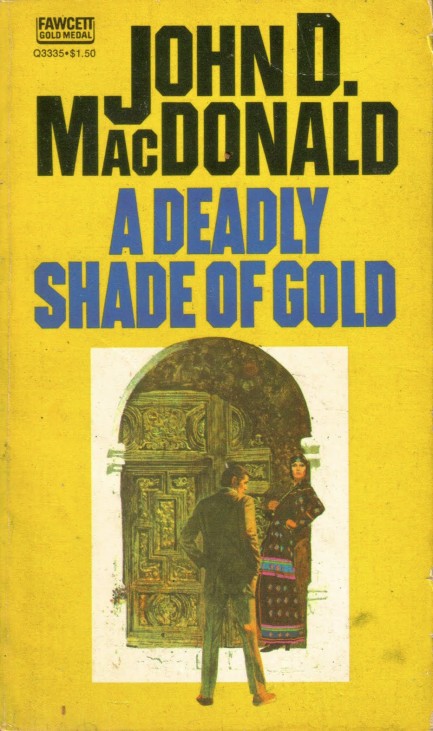
 It isn't easy being more highly evolved than everyone else. 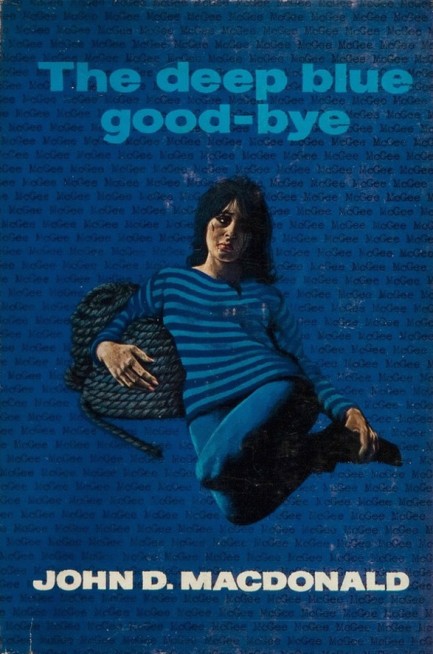 
These covers are from John D. MacDonald hardbacks published by British imprint Robert Hale during the mid-1960s, two entries in his famed Travis McGee series. Eight years ago we shared a selection of Fawcett Gold Medal paperback covers from the series which were painted by luminaries Ron Lesser, Elaine Duillo, Robert McGinnis, and others. You can see them here if you're inclined. When we put together that set we hadn't read any of the books, so we figured it was time to take ole John D. and his creation McGee for a spin.
We read the novels you see above and the results were a bit mixed for us. McGee is a sort of fixer who lives an idle life on a houseboat in Florida, but takes detective-like jobs whenever money runs short. Despite his laid back trappings, he's a cynical, hypercritical guy who thinks he knows everything about everyone. MacDonald tries to mitigate this somewhat by making McGee occasionally critical of himself, but it's just a fig leaf. The guy is an enormous pain—manipulative, often pointlessly mean, and of the opinion that he can discern facts about people that they don't know about themselves.
These assessments of others always turn out to be true, as you'd expect since they come from the star character, but we couldn't help thinking how in real life McGee would be a real trial to know. That's just our opinion. But here's what's indisputable—MacDonald's female characters are mentally weak and sexually neurotic. McGee sometimes treats them shabbily and they later thank him for shaking them up. In The Deep Blue Goodbye when a woman important to McGee dies, he has virtually no reaction. His aplomb is inconsistent, considering at other times we hear his deepest thoughts about everything from the sexual proclivities of hippies to the eventual fate of western civilization.
Our feelings about him are probably generational. We weren't even zygotes when these novels were published, so maybe this sort of jaundiced and superior cynicism played better back in the sixties when a major cultural shift was underway. Despite our quibbles, the plots of these novels are engaging, and McGee, though full of himself, isn't invincible. The difficulties he runs into are surprising, and often deadly, particularly in Nightmare in Pink, in which the villains manage to put him into an exceedingly tight spot. A palpable sense of menace in the fiction helps carry the day.
The art above was painted by the genius illustrator Barbara Walton, who was sort of a house artist for Robert Hale Limited, producing scores of dust jackets for the company. In fact, she was one of the greatest of dust jacket artists, someone whose work surpassed its boundaries to become fine art. That fact may not be fully clear here, but trust us. We haven't talked much about Walton because of our focus on paperbacks, but she was really something. You can see another example of her work (one of her least impressive pieces) here, and an entire gallery of good stuff here.
 Last one to leave turn out the lights. 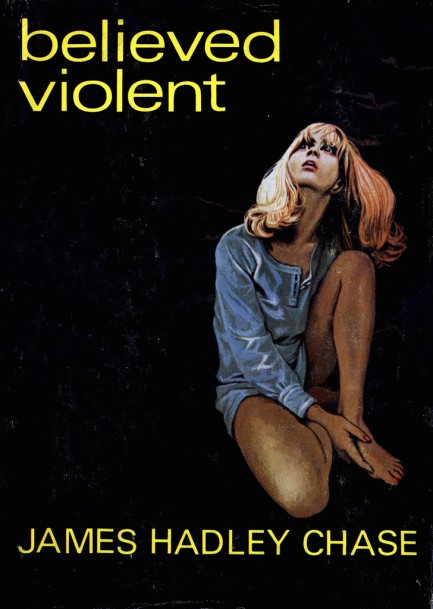
Above, a beautiful black dust jacket for James Hadley Chase's thriller Believed Violent, 1968, from British publisher Robert Hale Limited. Chase gets right into this one with an adulterous sex scene on the opening page, and serious repercussions resulting from the subsequent murder. The book evolves to become an espionage caper, with Russians willing to pay a fortune for the secret formula behind the manufacture of a revolutionary new metal. Against that backdrop you get the broken man behind the formula, a sadistic professional killer, a one-eyed henchman, a sex slave heroin addict whose eventual rebellion has pivotal consequences, and Chase's franchise character Frank Terrell. The art here, which is what we really wanted to show you, is from Barbara Walton. We've mentioned her only briefly but as you can see she was a top talent. We're going to get back to her a little later.
 Eileen Walton proves she’s just as talented as her sister. 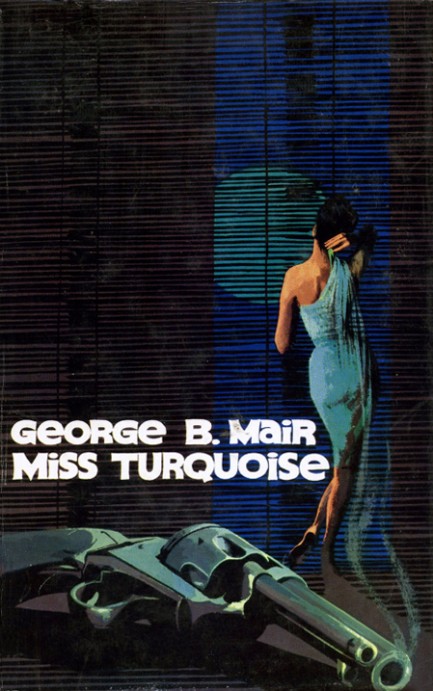
Last week we shared a group of book covers that used shadows or silhouettes of Venetian blinds as a theme. We stumbled across one more on Flickr—George B. Mair’s 1964 North African spy adventure Miss Turquoise. It’s the second of his books starring David Grant, a character he based loosely on himself. The art is by Eileen Walton, sister of illustrator Barbara Walton, and she shows that talent ran in the family with this lovely moonlit tableau for Jarrold Publishing. Thanks to the original uploader, and see the other covers of this ilk here.

|
 |

The headlines that mattered yesteryear.
2003—Hope Dies
Film legend Bob Hope dies of pneumonia two months after celebrating his 100th birthday. 1945—Churchill Given the Sack
In spite of admiring Winston Churchill as a great wartime leader, Britons elect
Clement Attlee the nation's new prime minister in a sweeping victory for the Labour Party over the Conservatives. 1952—Evita Peron Dies
Eva Duarte de Peron, aka Evita, wife of the president of the Argentine Republic, dies from cancer at age 33. Evita had brought the working classes into a position of political power never witnessed before, but was hated by the nation's powerful military class. She is lain to rest in Milan, Italy in a secret grave under a nun's name, but is eventually returned to Argentina for reburial beside her husband in 1974. 1943—Mussolini Calls It Quits
Italian dictator Benito Mussolini steps down as head of the armed forces and the government. It soon becomes clear that Il Duce did not relinquish power voluntarily, but was forced to resign after former Fascist colleagues turned against him. He is later installed by Germany as leader of the Italian Social Republic in the north of the country, but is killed by partisans in 1945.
|

|
|

It's easy. We have an uploader that makes it a snap. Use it to submit your art, text, header, and subhead. Your post can be funny, serious, or anything in between, as long as it's vintage pulp. You'll get a byline and experience the fleeting pride of free authorship. We'll edit your post for typos, but the rest is up to you. Click here to give us your best shot.

|
|








